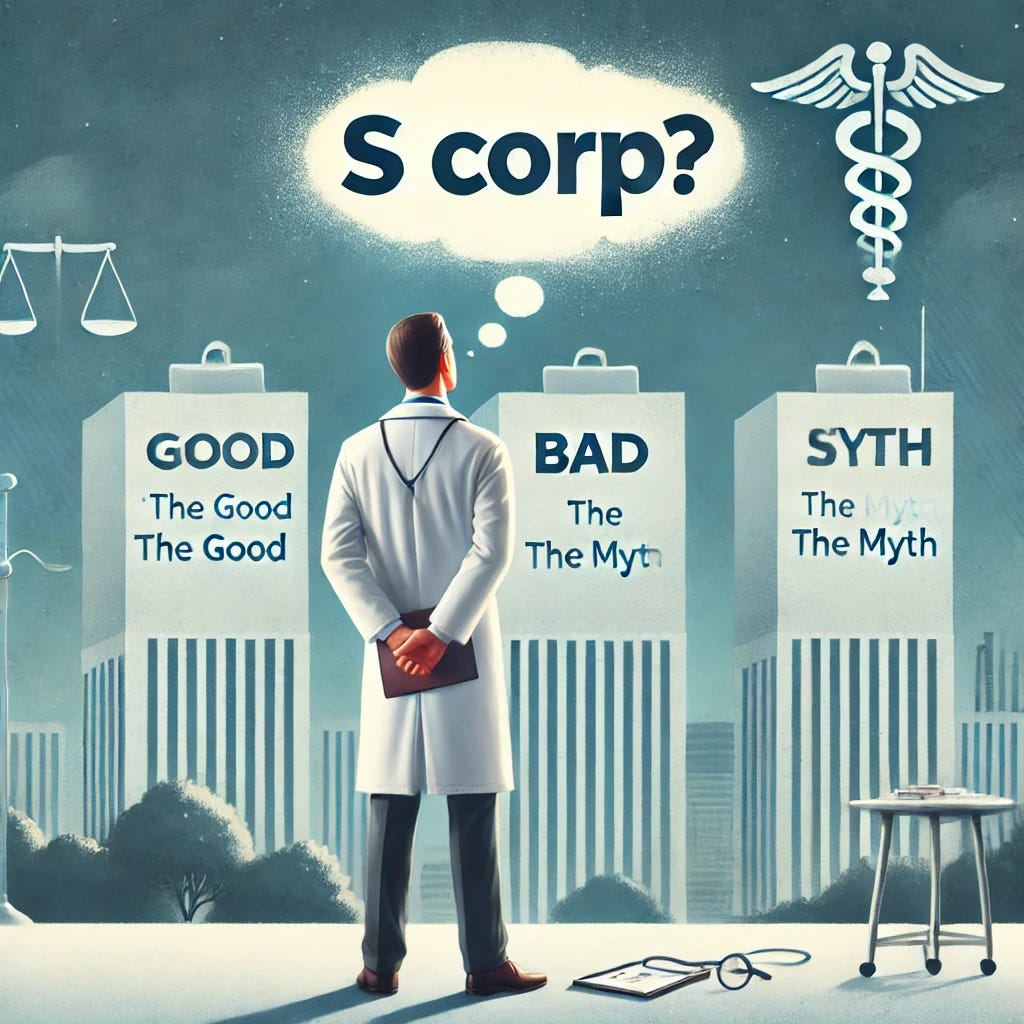Understanding S Corporations for Physicians: The Good, the Bad, and the Myths, Part 1/2
What Every Physician Should Know Before Electing S Corp Status
Earlier this week, I published two articles—one for graduating residents and fellows and another for practicing physicians with both W-2 and 1099 income—analyzing the tax implications of electing S corporation status.
This article provides an overview of what an S corporation is and examines both the advantages and disadvantages of the S corporation structure from a non-tax perspective.
The S corporation is one of the most widely discussed tax topics among physicians, alongside LLCs, Real Estate Professional Status (REPS), and short-term rental loopholes.
But what exactly is an S corporation? Who is it for, and how does it work?
At its core, an S corporation is not a type of entity—it is a tax election. This means that once you form a legal entity with your state (such as a corporation or an LLC), you must choose how that entity will be taxed.
An S corporation is one of four primary tax classifications:
C Corporation
S Corporation
Partnership
Sole Proprietorship
S corporations are heavily discussed in physician circles because most states require medical practices to be structured as corporations rather than LLCs due to corporate practice of medicine laws. These corporations can be taxed either as S corporations or C corporations.
Physicians often elect S corporation status because C corporations face double taxation—meaning the corporation itself pays taxes, and then any remaining income distributed to shareholders is taxed again at the individual level.
By contrast, S corporations are pass-through entities. This means that business income, losses, credits, and deductions pass through to the individual shareholders and are reported on their personal tax returns.
In short, an S corporation is simply a tax election that allows an entity to be taxed in a particular manner.
The “S” in S corporation stands for “Small”—these corporations are designed for small businesses with fewer than 100 shareholders/owners.
If your state allows LLCs for medical practices, you have additional flexibility—you may elect to have your LLC taxed as an S corporation, a C corporation, a partnership, or a sole proprietorship, depending on eligibility.
If I Have 1099 Income, Do I Need to Set Up an S Corporation?
The first question you should ask yourself is:
Do I need liability protection?
An entity can provide protection from certain business liabilities, such as:
Contractual Liabilities: If your entity signs a contract to provide ER coverage for four shifts a month, the entity (not you personally) is responsible for fulfilling that contract. If the contract is violated, the hospital may sue the entity rather than you, its employee, helping to keep your personal assets protected from any judgment against the corporation.
Employment Liabilities: If you hire an assistant to manage your schedule and they later sue for unpaid overtime or emotional distress, the lawsuit would typically be against your entity, not you personally.
Premises Liability (If You Own a Clinic): If a patient slips and falls in your waiting room, suffers an epidural hematoma, and files a lawsuit for permanent disability, your entity—not you personally—would generally be liable, meaning only the business assets would be at risk.
However, it is crucial to understand that forming an entity does not protect you from malpractice lawsuits. If you face a $10 million malpractice claim, having an S corporation will not shield your personal assets—this is why malpractice insurance is essential.
Disclaimer: I am not an attorney, and this is based on my knowledge as a tax professional. You should consult with a business attorney to fully understand the legal protections available to you.
What Do I Need to Do to Establish an S Corporation?
Setting up an S corporation involves both state-level and IRS-level requirements.
Here’s what you need to do:
First, you’ll need to form a legal entity with your state. Depending on your state’s regulations, this will typically be either a Professional Corporation (PC) or a Professional Limited Liability Company (PLLC) since you are a licensed physician. It’s important to note that this step is purely a legal requirement—it does not determine how the business will be taxed.
Once your entity is established at the state level, you must decide how it will be taxed. By default, a PC is taxed as a C corporation unless you take action to elect S corporation status. To make this election, you must file IRS Form 2553 and Form 8832 with the IRS in a timely manner.
If your entity is an PLLC, the default tax classification depends on how many owners (members) the PLLC has.
A single-member PLLC (one owner) is automatically taxed as a sole proprietorship unless either an S or C corporation election is made.
A multi-member PLLC (more than one owner) is automatically taxed as a partnership unless either an S or C corporation election is made.
In either case, to have the PLLC taxed as an S corporation, you must file Form 2553 with the IRS.
By carefully following these steps, you can ensure that your entity is structured correctly and benefits from the tax advantages of an S corporation election.
The rest of the topics will be covered in the next article, including:
What Are the Compliance Requirements for an S Corporation?
Common Myths About S Corporations
Final Thoughts: Is an S Corporation Right for You?
Disclaimer: click here





